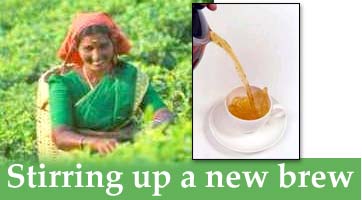Home > Business > Special
Ishita Ayan Dutt |
March 20, 2004

They were the pride of the Indian tea industry. Acres of rolling green dotted with tea bushes from which the estate owners supplied the world and -- in the process -- brewed big bucks.
How times have changed. Today the giant tea companies say that their sprawling tea estates are a losing proposition.
The prices of bulk tea have fallen steadily in recent years and its getting tougher to squeeze money from ageing estates.
That's OK for a company like Hindustan Lever which has always been a big player in the branded tea market. But it's extremely tough for the others.
Indians are still drinking tea so there's hope for the industry. But the top companies have finally figured that -- like other industries -- they must move out of the commodity business and start building brands.
Take a look at industry behemoth Tata Tea. Not long ago, the company's plantations in places like Munnar and Assam contributed around 80 per cent of the company's turnover. Today that's down to 14 per cent.
Where does Tata Tea's money come from these days? From branded tea that's sold under different names in different parts of the country. At the national level, Tata Tea has brands like Tata Tea, Tetley and Agni.
Tata Tea has a twin-pronged strategy that is paying dividends. It also has a clutch of strong regional brands that have carved out niches in pockets.
There is, for instance, Kanan Devan which is popular and which dominates in Kerala, Karnataka, Tamil Nadu and Goa. Then, there's Chakra Gold in Andhra Pradesh and Tamil Nadu.
Also, there's Gemini which has a strong presence in some pockets of Andhra Pradesh. The company is hoping to build these brands into an even more powerful combination in the marketplace.
"We will make more out of existing brands," says Percy Siganporia, deputy managing director, Tata Tea.
Or, take a look at the Khaitan group which was once the country's largest producer of bulk tea. The Khaitan's made a half-hearted foray into branded tea a few years ago by launching three brands -- Jaago, Tez and Premium Gold. Now they are making a concerted effort once again to push these brands.
The Khaitans already sell about 4,500 tonnes of packaged tea and they would like to push that to about 6,000 tonne in 2005-06 and to 8,000 tonne by 2006-07 and 10,000 tonne in the following year.
What's more the Khaitans are using the Eveready battery distribution network and hoping that will help to boost sales rapidly.
Currently, around 65 per cent of its battery distributors carry tea. The aim is to ensure that 100 per cent of the distributors also carry packet tea.
Why are the Khaitan's also looking so seriously at packaged tea? "Bulk tea has limitations in pricing. Prices can go up to a certain level, while costs keep increasing," says Deepak Khaitan, executive vice chairman and managing director of Eveready Industries India. The Khaitans are also considering launching a new brand for the premium segment.
Certainly, the figures seem to show that packaged tea is growing. Not surprisingly, the industry estimates that packet tea volumes to have grown to 300 million kg, from 250 million kg over the last couple of years, a sign of growth in a largely stagnating industry. The growth potential is considered to be immense in a market which is estimated to be 860 million kg.
Companies like Tata Tea are drawing up careful strategies for the future. For instance, the company is borrowing procedures used by Tetley in its international operations.
There will, for instance, be different brand managers so that the levels of control are better organised. Also, there should be a dramatic change in the benchmarking process and there will be more consumer feedback on the product.
There is one big ray of hope for the tea companies. So far, there's no sign that Indians are losing their taste for tea. In fact, quite the contrary. The tea market is growing at quite a healthy speed.
Though the figures are still being debated in the industry circles, the trade puts the consumption figure at 700 million kg, which is a significant improvement over 650 million kg the year before. For the next year, the industry is expecting it to climb to 720 million kg.
One clear indication that consumption is still rising is that at the end of the season the industry is left with virtually no tea. The stock level is currently at its lowest in the last 10 years. Therefore, the tea industry is hoping for better opening prices when the fresh tea for this year arrives at auctions.
The tea companies are hence making a beeline to cash in on growth and this time around they plan to pursue packet tea plans on a war-footing. But this time round everyone is looking at brands to bring in the money.
One indication of how seriously the companies are now taking branding: the Khaitans have even starting putting the WM (William Magor) logo on their bulk tea. Khaitan says, this helps the company charge a premium in the market over other teas of the same quality.
Even smaller companies like Dhunseri Tea are looking more seriously at selling packaged tea. Dhunseri has 13 estates that produce 12 million kg of tea and it has three brands Lal Ghoda and Kala Ghoda and Chhote Lal.
However, the three brands are only strong in Rajasthan and C K Dhanuka, chairman Dhunseri Tea wants to ensure that they remain strong regional brands. Nevertheless, he knows it is important to reduce his dependence on loose tea.
The tea industry is facing challenges from around the world. if they can strengthen their brands in the domestic market it will be a big step forward.
Powered by 